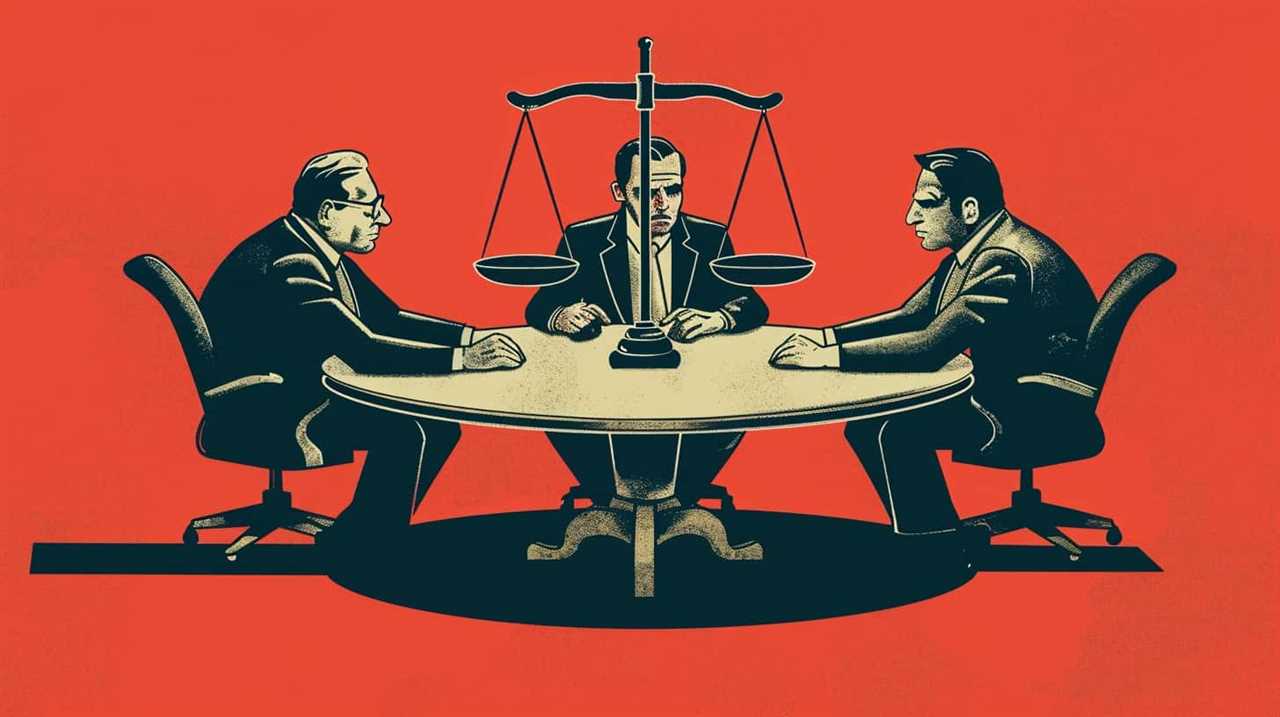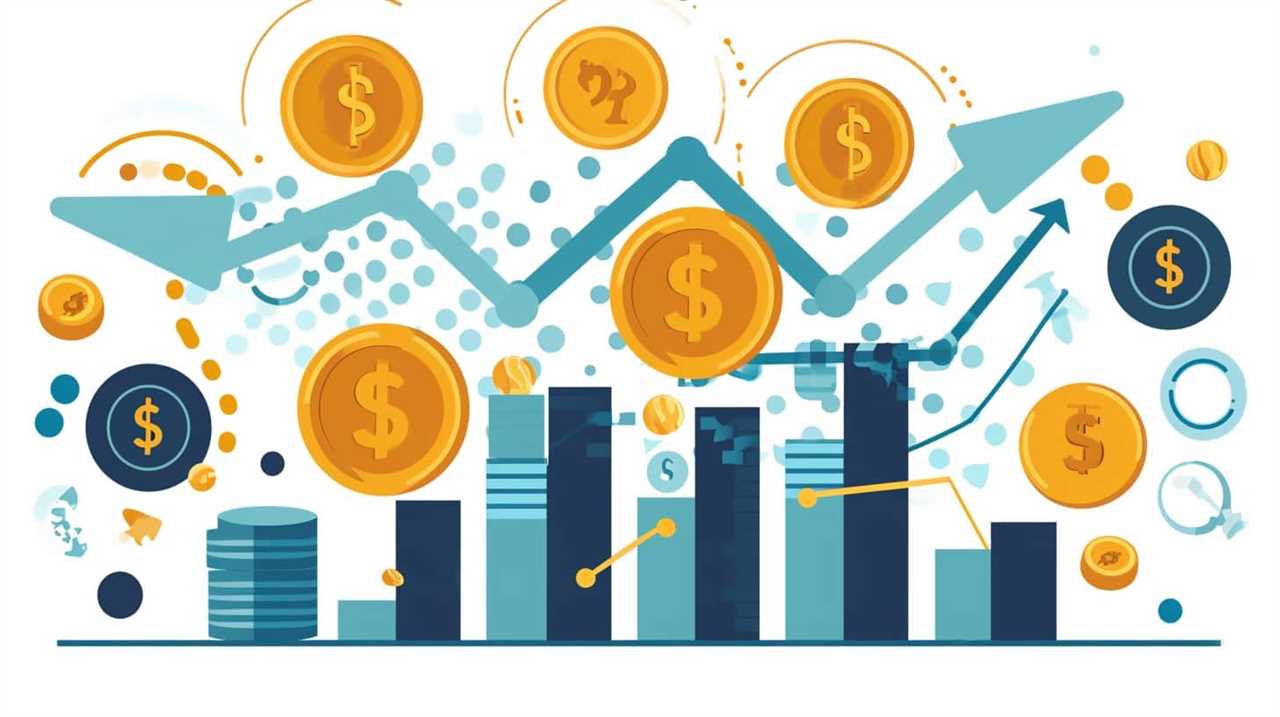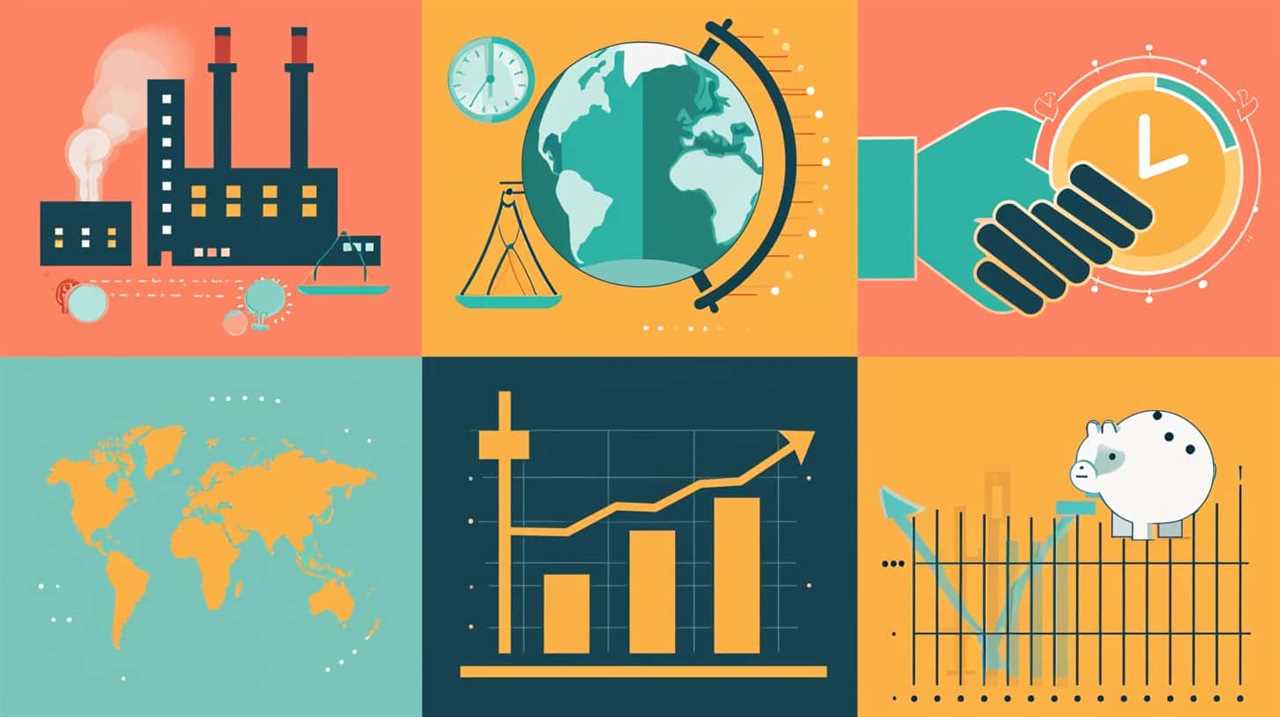Are you ready to unlock the secrets of Hayek’s Price Theory? In our groundbreaking guide, ‘Mastering Hayek’s Price Theory: 10 Essential Tips,’ we’ll take you on a journey of innovation and discovery.
This isn’t your typical textbook study – we’ll dive deep into the intricacies of the price mechanism, exploring the role of supply and demand, the importance of individual knowledge, and the market process and coordination.
As we unravel the mysteries of spontaneous order in the economy and Hayek’s critique of price controls, you’ll gain invaluable insights into inflation, price signals, and resource allocation. By the end, you’ll have a profound understanding of the implications for economic policy.
Join us on this transformative adventure and revolutionize your understanding of Hayek’s Price Theory!

Key Takeaways
- The price mechanism is determined by supply and demand, and it serves as a signaling system for buyers and sellers.
- Individual knowledge and personal expertise are crucial for accurate assessments, informed choices, and effective problem-solving.
- The economic decision-making process is influenced by individual knowledge and shapes policies for growth and stability.
- The market process and coordination rely on price signals to facilitate resource allocation and efficient economic activities.
Understanding the Price Mechanism
Understanding the price mechanism is crucial for grasping the functioning of market economies. The price mechanism refers to the way prices are determined in a market, based on the interaction of supply and demand. It’s a fundamental concept in economics that plays a vital role in market coordination.
The price mechanism acts as a signaling system, providing information to buyers and sellers about the relative scarcity and value of goods and services. Through the forces of supply and demand, prices adjust to balance the desires of consumers and the available resources. When demand exceeds supply, prices rise, signaling an opportunity for producers to increase production and earn higher profits. Conversely, when supply exceeds demand, prices fall, signaling the need for producers to reduce output or find alternative markets.
Market coordination relies on the price mechanism to allocate resources efficiently. By allowing prices to fluctuate freely, the price mechanism encourages producers to respond to changing market conditions. It incentivizes innovation, as entrepreneurs seek out new ways to meet consumer demands and earn profits. Furthermore, the price mechanism fosters competition, as producers strive to offer better products at competitive prices.
Role of Supply and Demand
Now, let’s delve into the role of supply and demand in Hayek’s price theory. Supply and demand are the driving forces behind market prices and play a crucial role in determining the allocation of resources in an economy. Furthermore, supply and demand analysis insights provide valuable information about consumer preferences and behavior, as well as the availability and cost of production inputs. By understanding these insights, businesses and policymakers can make more informed decisions about pricing, production levels, and resource allocation. This knowledge allows for a more efficient and well-functioning market economy, ultimately leading to greater overall economic prosperity.

Here are four key points to understand about the role of supply and demand:
- Interplay of Forces: Supply represents the quantity of goods or services that producers are willing to offer at a given price, while demand represents the quantity that consumers are willing to buy at a given price. The interaction between supply and demand determines the equilibrium price and quantity in a market.
- Price Signals: Hayek emphasized the importance of prices as signals that convey information about scarcity and value. Changes in supply and demand lead to price adjustments, which in turn guide producers and consumers in their decision-making process.
- Market Efficiency: Hayek argued that market prices, determined by the forces of supply and demand, reflect the underlying economic realities more accurately than any central authority could. This price mechanism ensures that resources are allocated efficiently, responding to changes in supply and demand.
- Dynamic Equilibrium: Supply and demand aren’t static, but rather dynamic forces that are constantly changing. Hayek’s price theory recognizes that markets are in a perpetual state of adjustment, as supply and demand evolve over time.
Understanding the role of supply and demand in Hayek’s price theory is crucial for grasping the intricate workings of market economies. By analyzing the interplay of forces, price signals, market efficiency, and dynamic equilibrium, we can gain valuable insights into the functioning of modern economies and drive innovation forward.
Importance of Individual Knowledge
Personal expertise plays a crucial role in determining one’s success in the economic decision-making process. Understanding the importance of individual knowledge allows us to recognize that each person possesses unique insights, experiences, and skills that can contribute to more accurate assessments and informed choices.
Personal Expertise and Success
With our individual knowledge, we can navigate the path to success and achieve personal expertise. Personal growth and achieving goals are essential components of this journey.

Here are four key factors that highlight the importance of individual knowledge in attaining personal expertise and success:
- Continuous learning: Embracing a mindset of lifelong learning allows us to constantly acquire new knowledge and skills, enabling us to adapt and excel in a rapidly changing world.
- Specialization: Developing expertise in a specific field or area allows us to stand out and offer unique value, increasing our chances of success.
- Problem-solving abilities: Having a deep understanding of a subject matter equips us with the tools to effectively address challenges and find innovative solutions.
- Confidence and self-belief: Building expertise in a particular domain instills confidence in our abilities, empowering us to take risks and seize opportunities.
Economic Decision-Making Process
Our individual knowledge plays a crucial role in the economic decision-making process. When it comes to economic decision making, consumers rely on their knowledge and understanding of various factors such as prices, quality, and availability of goods and services. This knowledge helps consumers make informed choices that align with their preferences and needs.
Understanding consumer behavior is essential for businesses as it allows them to tailor their products and marketing strategies to meet consumer demands. Additionally, individual knowledge also influences economic decision making on a larger scale, as policymakers and government officials rely on this knowledge to shape economic policies that promote growth and stability.
Therefore, recognizing the importance of individual knowledge in the economic decision-making process is essential for both individual consumers and society as a whole.

Market Process and Coordination
One crucial aspect of Hayek’s Price Theory is understanding the market process and how it facilitates coordination. The market process refers to the dynamic interactions between buyers and sellers that lead to the establishment of market equilibrium and the efficient allocation of resources. Through this process, prices play a crucial role in coordinating the actions of individuals, ensuring that resources are allocated to their most valued uses.
To grasp the significance of the market process and coordination, consider the following:
- Price signals: Prices serve as important signals in the market, conveying information about relative scarcity and demand. They guide individuals in making decisions regarding production, consumption, and investment.
- Price discovery: The market process enables the discovery of prices through the interaction of buyers and sellers. These prices reflect the collective knowledge and preferences of market participants, providing valuable information for decision-making.
- Competition: Competition within the market process fosters efficiency and innovation. It incentivizes producers to offer better products at lower prices, driving continuous improvement and economic progress.
- Spontaneous order: The market process generates a spontaneous order, where individual actions, driven by self-interest, result in a coordinated outcome that benefits society as a whole.
Understanding the market process and coordination is essential for harnessing the power of markets and promoting innovation. By studying Hayek’s Price Theory, individuals can gain valuable insights into how markets work, enabling them to make informed decisions and contribute to economic growth.
Spontaneous Order in the Economy
The spontaneous order in the economy emerges from the interactions of market participants, shaping the allocation of resources and fostering economic progress. It’s a concept that emphasizes the decentralized nature of the market and the coordination that arises from individual actions. In a spontaneously ordered economy, there’s no central authority directing the allocation of resources. Instead, market participants make decisions based on their own self-interests, leading to the emergence of a complex system of prices, production, and exchange.

This spontaneous order is driven by the fundamental principle of market coordination. As individuals pursue their own goals, they respond to signals in the form of prices, which convey crucial information about scarcity and demand. Through this process, resources are allocated efficiently, with goods and services flowing to where they’re most valued. This coordination isn’t the result of a conscious design, but rather the unintended outcome of countless interactions between buyers and sellers.
The concept of spontaneous order highlights the power of the market to self-organize and adapt to changing circumstances. It demonstrates how a decentralized system, driven by individual actions and market prices, can lead to a more efficient allocation of resources than a centrally planned economy. By allowing individuals the freedom to make choices and engage in voluntary exchange, spontaneous order unleashes the innovative potential of individuals, leading to economic progress and prosperity.
The Fallacy of Central Planning
Central planning, despite its intentions, is inherently flawed and limited in its ability to efficiently allocate resources. The market, driven by the forces of supply and demand, is a more effective mechanism for resource allocation due to its decentralized nature and ability to adapt to changes in conditions.
Hayek’s critique of central planning highlights the dangers of relying on a centralized authority to make economic decisions, as it ignores the complex and dynamic nature of the market.

Limitations of Central Planning
We frequently encounter the fallacy of central planning, which highlights the limitations of attempting to centrally plan an economy. While central planning may seem like an effective way to allocate resources and achieve economic goals, it’s important to recognize its drawbacks.
Here are some key limitations of central planning:
- Lack of information: Central planners don’t have access to the same level of information as individuals and businesses in a decentralized market. This can lead to inefficient resource allocation and misjudgment of consumer preferences.
- Inflexibility: Central planning often involves rigid rules and regulations, which can impede innovation and adaptation to changing market conditions.
- Incentive problems: Without the profit motive and market competition, central planners may struggle to incentivize productivity and innovation.
- Lack of diversity: Central planning tends to limit diversity and experimentation, stifling creativity and hindering the discovery of new solutions.
These limitations demonstrate the challenges faced by central planners in effectively managing an economy and highlight the advantages of a decentralized market system.
Market Efficiency Vs. Planning
When considering market efficiency versus planning, it’s crucial to understand the fallacy of central planning.

Market competition plays a pivotal role in driving efficiency and innovation. In a competitive market, businesses strive to produce goods and services that meet consumers’ demands at the lowest possible cost. This constant drive for efficiency leads to the allocation of resources in the most productive manner.
On the other hand, central planning, which involves government intervention in economic decision-making, tends to hinder market competition. When the government controls production and distribution, it often leads to inefficiencies, as there’s no mechanism for market signals to guide resource allocation. This lack of competition and reliance on centralized planning can stifle innovation and hinder economic growth.
Therefore, market efficiency through competition is a superior alternative to central planning.
Hayek’s Critique of Planning
In our exploration of Hayek’s critique of planning, we uncover the fallacy of central planning. Hayek’s criticism of socialist planning centers around the idea that it’s impossible for a central authority to possess the knowledge required to efficiently allocate resources in an economy.

Here are four key points to consider:
- Hayek argues that the dispersed knowledge possessed by individuals in a market economy can’t be effectively aggregated by a central planner.
- Central planning neglects the role of prices as information signals that guide resource allocation.
- Socialist planning fails to account for the dynamic and ever-changing nature of the economy, making it unable to adapt to new information and circumstances.
- The absence of competition in centrally planned economies leads to a lack of innovation and a stifling of entrepreneurial spirit.
Hayek’s critique of planning highlights the inherent limitations and inefficiencies of centralized decision-making, emphasizing the importance of decentralized market processes for economic coordination.
Hayek’s Critique of Price Controls
Hayek’s critique focuses on the negative consequences of price controls. According to Hayek, government intervention in the form of price controls leads to market distortions. Price controls, which involve setting maximum or minimum prices for goods and services, are implemented with the intention of protecting consumers or producers from high or low prices respectively. However, Hayek argues that price controls interfere with the natural functioning of the market mechanism and create unintended consequences.
One of the main problems with price controls is that they disrupt the price signals that are crucial for coordinating economic activity. Prices serve as information carriers in the market, conveying the relative scarcity and value of goods and services. When the government sets prices artificially, it distorts these signals, leading to misallocation of resources. For instance, if the government sets a maximum price for a product below its market equilibrium price, it creates a shortage as suppliers are unwilling to produce at that price. This can result in long queues, black markets, and even higher prices in the long run.

Another issue with price controls is that they discourage innovation and competition. When prices are controlled, there’s less incentive for businesses to invest in research and development or to improve efficiency. Without the ability to set prices based on market conditions, businesses may struggle to cover their costs, leading to reduced investment in new technologies and processes. Furthermore, price controls can create barriers to entry for new competitors, as established firms can use their market power to influence the setting of prices in their favor.
Hayek’s View on Inflation
Hayek’s insights on inflation provide valuable perspectives on the potential consequences and dangers of monetary expansion.
By emphasizing the role of money as a medium of exchange and a store of value, Hayek highlights the detrimental effects of inflation on price stability and economic coordination.
Understanding Hayek’s inflation implications can help us appreciate the importance of sound monetary policy and the need to avoid excessive money creation, which can lead to distortions in the price system and hinder market efficiency.

Hayek’s Inflation Insights
We frequently explore Hayek’s insightful perspective on inflation in our journey of mastering his price theory. Hayek’s inflation analysis sheds light on the relationship between inflation and economic stability. Here are some key insights:
- Inflation disrupts the price mechanism: Hayek argued that inflation distorts the signals conveyed by prices, making economic calculation and resource allocation more difficult.
- Inflation erodes the value of money: Hayek emphasized that inflation reduces the purchasing power of money, leading to a decline in real wages and savings.
- Inflation creates uncertainty: According to Hayek, inflation introduces uncertainty into the economic system, making it harder for businesses and individuals to plan for the future.
- Inflation can lead to economic crises: Hayek warned that unchecked inflation can result in severe economic downturns and financial instability.
Understanding Hayek’s inflation analysis helps us grasp the implications of inflation on economic stability and the importance of maintaining price stability.
Hayek’s Inflation Implications
As we delve deeper into Hayek’s price theory, it’s important to consider the implications of inflation. Inflation disrupts the price mechanism and erodes the value of money. Hayek believed that inflation is primarily caused by an expansion of the money supply, which leads to a general rise in prices. This increase in prices distorts the signals that prices convey in a market economy, making it difficult for individuals to make rational economic decisions.
Inflation also has other negative effects. It redistributes wealth from savers to debtors and creates uncertainty about future prices. Hayek argued that a stable monetary system is crucial for maintaining a healthy economy and preventing the harmful effects of inflation. Understanding Hayek’s view on inflation can help us better comprehend the importance of price stability in a market economy.

Price Signals and Resource Allocation
Price signals play a crucial role in efficiently allocating resources in an economy. These signals, conveyed through the prices of goods and services, provide valuable information to producers and consumers, guiding them in their decision-making processes. Here are four key points to highlight the significance of price signals in resource allocation:
- Efficiency: Price signals help ensure that resources are allocated to their most valuable uses, as prices reflect the relative scarcity and demand for different goods and services. When prices rise, it indicates increased demand and scarcity, signaling producers to allocate more resources towards those goods or services.
- Innovation: Price signals encourage innovation by creating incentives for entrepreneurs and businesses to develop new products or improve existing ones. Higher prices for innovative goods or services indicate a willingness to pay for novelty, prompting entrepreneurs to invest in research and development.
- Competition: Price signals foster competition among producers, motivating them to offer better products at lower prices. This competition drives efficiency and encourages the allocation of resources towards the most efficient producers, benefiting consumers through lower prices and improved quality.
- Market coordination: Price signals facilitate the coordination of economic activities across different sectors and regions. As prices adjust based on changes in supply and demand, resources can be efficiently directed to where they’re most needed, ensuring that goods and services are produced and distributed in the most optimal way.
Implications for Economic Policy
Continuing from the previous subtopic of price signals and resource allocation, it is important to consider the implications for economic policy. Hayek’s price theory suggests that the market, through the price system, efficiently allocates resources and coordinates economic activity. This insight has significant implications for economic policy, particularly in areas such as economic stability and government intervention.
When it comes to economic stability, Hayek argues that government intervention can disrupt the natural functioning of the market and lead to unintended consequences. By manipulating prices or controlling resource allocation, policymakers may inadvertently create imbalances in the economy, hindering long-term growth and stability. Hayek emphasizes the importance of allowing market forces, guided by price signals, to determine the allocation of resources and coordinate economic activity.
To better understand the implications for economic policy, let’s consider the following table:

| Implications for Economic Policy |
|---|
| Economic Stability |
| Government Intervention |
In terms of economic stability, Hayek’s price theory suggests that a hands-off approach, with minimal government intervention, is often more conducive to long-term stability. By allowing prices to freely adjust, the market can efficiently respond to changes in supply and demand, leading to a more stable and balanced economy.
Government intervention, on the other hand, can disrupt the price mechanism and distort resource allocation. While there may be instances where government intervention is necessary to address market failures or externalities, Hayek cautions against excessive interference, as it can lead to unintended consequences and hinder economic efficiency.
Frequently Asked Questions
How Did Hayek’s View on Inflation Evolve Over Time?
Over time, our understanding of Hayek’s perspective on inflation has evolved. We have come to recognize the dynamic nature of his views and how they changed in response to new economic developments and empirical evidence.
What Are Some Specific Examples of Price Signals and How They Affect Resource Allocation?
Price signals play a crucial role in resource allocation by providing valuable information to businesses and individuals. Examples include changes in market prices, interest rates, and exchange rates, all influencing decision-making and driving innovation.

How Does Hayek’s Critique of Price Controls Relate to Government Intervention in the Economy?
Government intervention in the economy through price controls is closely scrutinized by Hayek’s critique. He argues that such controls distort price signals, leading to inefficient resource allocation and hindering innovation and progress.
What Are the Main Implications of Hayek’s Price Theory for Economic Policy?
The main implications of Hayek’s price theory for economic policy include promoting economic efficiency through market competition. By allowing prices to freely fluctuate, resources are allocated more efficiently, leading to innovation and growth.
Are There Any Real-World Examples That Demonstrate the Concept of Spontaneous Order in the Economy?
There are several real-world examples that illustrate the concept of spontaneous order in the economy. These examples demonstrate the effectiveness of Hayek’s concept of spontaneous order in promoting innovation and efficiency.
Conclusion
In conclusion, mastering Hayek’s price theory is essential for understanding the intricate workings of the economy. The price mechanism, supply and demand, individual knowledge, and market coordination all play crucial roles in achieving economic efficiency.

Hayek’s critique of price controls and his view on inflation highlight the importance of allowing the market to function freely. By recognizing the significance of price signals and resource allocation, policymakers can make informed decisions that promote economic growth and prosperity.
It’s imperative that we grasp these concepts to navigate the complexities of the modern economy effectively.
Lauren’s talent in writing is matched by her passion for storytelling. Her love for books and deep understanding of culture and entertainment add a distinct flavor to her work. As our media and press contact, Lauren skillfully bridges the gap between afterQuotes and the broader media landscape, bringing our message to a wider audience.










